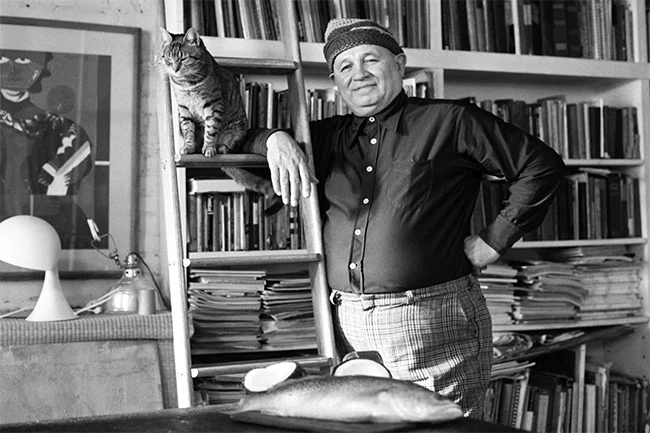Romare Bearden
(Photo by Blaine Waller) via Queen City Nerve.
Romare Bearden was born in Charlotte, North Carolina in 1911. At the age of three, Bearden moved with his family to Harlem. Bearden attended Lincoln University and Boston University before, ultimately, graduating from New York University, with a degree in education. While at NYU, he took art courses and was the lead cartoonist and art editor for The Medley. Bearden studied painting under George Grosz at the Art Students League of New York. He later became close friends with Stuart Davis, who also served as his mentor.
Bearden settled in New York City where he was a social worker and worked on his art at night and during the weekends. He had his first solo exhibition in Harlem in 1940. Bearden was an accomplished jazz musician which heavily influenced his art.
He worked with many mediums and in different styles, but he is best known for his richly textured collages where he used a broad range of colorful images from varied sources. These collages focused on elements of Black life and included influences from his time spent in Mecklenburg County, North Carolina, Pittsburgh, and Harlem. Examples of his collages appeared on the covers of Time and Fortune magazines in 1968. In 1971, Bearden became the second Black artist to receive a solo exhibition at the Museum of Modern Art where his large-scale collage Patchwork Quilt was displayed.
Bearden was involved in many arts organizations including the Harlem Arts Guild, The Harlem Cultural Council and The Studio Museum in Harlem. He founded Cinque Gallery with Norman Lewis to provide opportunities for young black artists. He was a founding member of the Black Academy of Arts and Letters and was elected to the National Institute of Arts and Letters in 1972. He has been the subject of retrospectives at the Museum of Modern Art in New York, NY (1971); Mint Museum of Art in Charlotte, NC (1980); Detroit Institute of the Arts in Detroit, Michigan (1986); Studio Museum in Harlem in New York, NY (1991); and the National Gallery of Art in Washington, DC (2003); Mint Museum of Art in Charlotte, NC (2012); Smithsonian in Washington, DC (2012); and Long Island Museum in Stony Brook (2023). His work is represented in notable collections across the country including the Metropolitan Museum of Art, New York, Museum of Modern Art, New York, Whitney Museum of American Art, New York, National Gallery of Art, Washington, DC, Philadelphia Museum of Art, PA, Museum of Fine Arts, Boston, and Studio Museum in Harlem, NY.

